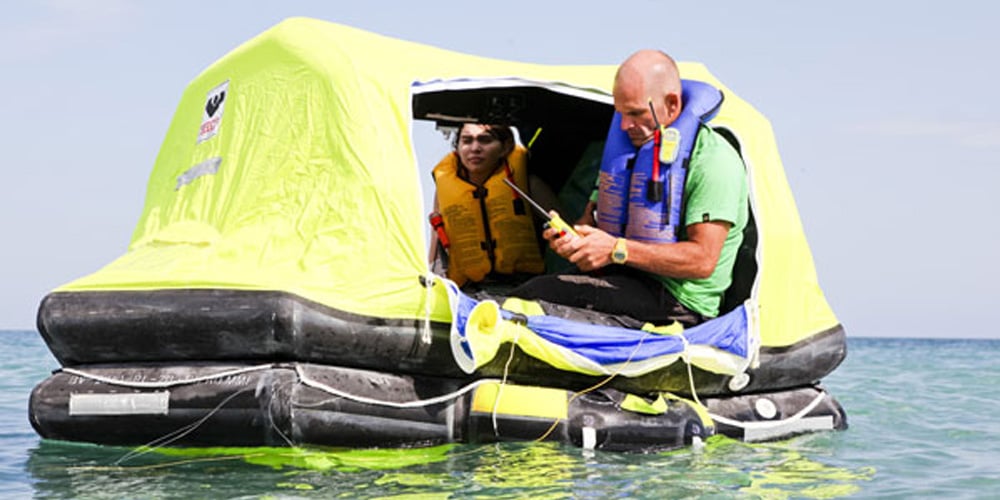
Considering a Life Raft
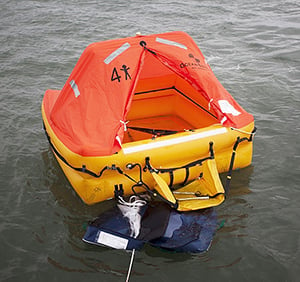
This four-person Ocean ISO Life Raft is a tiny shelter, but it’s better than being in the water!
Are you departing on a cruising voyage, heading offshore for fishing, competing in an offshore sailing race or taking part in a cruising rally? If so, you may be considering buying or renting a life raft.
Modern boats are wonders of reliability. They seldom sink or catch fire, but if they do the ocean, or even your local inland lake, is an inhospitable environment to be thrown into. You need the protection supplied by a life raft.
A life raft is designed to keep the crew of a sunk, capsized, burned or otherwise uninhabitable boat alive until they can be rescued. It’s the most important piece of equipment on your boat that you hope you’ll never use. While life rafts provide minimal environmental protection, they keep your crew out of the water and create a larger visual and radar target for rescuers. This article will help you choose the right one for you and your boat.
- Situations Where You Need a Life Raft
- Time to Anticipated Rescue
- Raft Standards
- Inshore Boating
- Coastal and Near Shore Boating
- Offshore or Ocean Boating
- Storage Options
- Your Ditch Bag
- Launching the Life Raft
Situations When You Need a Life Raft
An onboard fire started by a short in the electrical system or flammables materials in the engine room or a collision with a floating object such as a shipping cargo container or large marine mammal are the most likely scenarios where you’ll need to rapidly get off your boat.
Prudent offshore boaters prepare for these types of worst-case situations and create standard operating procedures (SOPs) to overcome emergencies. These plans include, when all efforts have failed, gathering crewmembers together and deploying the life raft.
Abandoning ship into the raft should always be the choice of last resort, hence the axiom that you should always STEP UP from the boat into the raft. There are tragic accounts of boaters who perished in their relatively tiny and unsheltered rafts after abandoning damaged vessels that were later found adrift, afloat and uninhabited. Board your raft only when there are no other options left.
Time to Anticipated Rescue
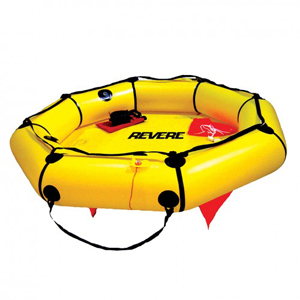
Revere Supply's Coastal Compact Life Raft is a calm-water, inland solution, for four people, and is better than jumping in the drink with your life vest on. A sudden sinking or out-of-control fire would make you glad to have this platform.

The raft weighs about 16 pounds, and most of that weight is in the inflating cylinder.
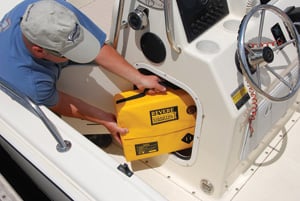
A good choice for the coastal fishing boat.
How long you’re likely to wait for the Coast Guard or other rescue assets is one of the key variables in choosing a life raft. Is it likely that you’ll be rescued in less than 24 hours? Many rafts offer a choice between a “less than 24 hours” or a “more than 24 hours” equipment pack. Consider how far from help you will be and choose accordingly.
Raft Standards from Different Eras
Life rafts we offer come from several suppliers, and are certified by different agencies using older or newer standards. Some were built to older Offshore Racing Council (ORC) requirements. Others are designed to meet ISO 9650 guidelines, which were put in place in 2005 after the 1998 Sydney to Hobart Race, which was one of the most notorious disasters in offshore racing history.
To reduce the confusion, we’ll look at the functional classes of rafts, let you know the type of boating they’re intended for and offer the group of standards each class meets. We’ll begin with the most sheltered environment: Inshore boating.
Inshore Boating
Rescue platforms are the smallest and most inexpensive rescue buoyancy aids, bridging the gap between life jackets and full-featured life rafts. They’ll keep your crew out of the water and reduce your risk of hypothermia while waiting for rescue. These flat discs include virtually no gear, a minimal ballast bag system and often no canopy or other type of cover.
They’re for inshore use, including locations typically up to 15 miles from shore, within VHF radio or cell phone range, and in close proximity to Search and Rescue (SAR) assets from the Coast Guard or other agencies.
In warm-water environments, you might not need a raft at all, but you might instead consider having an inflatable or rigid dinghy available for rapid deployment. With colder climates—the Northeast, Great Lakes, Pacific Northwest and Northern California, for example—you should strongly consider carrying a rescue platform, coastal or near shore raft to keep you and your crew out of the water when operating in frigid temperatures. Hypothermia can kill anyone immersed in 50° water in just two hours, and will quickly render you unable to function.
Coastal and Near Shore Boating
Coastal or near shore rafts are designed to protect boaters in inshore or warmer coastal waters for up to 24 hours. They often come with an un-insulated single-layer floor, smaller ballast bags, a canopy and a boarding ladder (usually webbing).
Their use would typically include locations up to 50 miles from shore, in areas where large amounts of shipping traffic are present, with SAR coverage rapidly deployable.
One of the myths about boating is that coastal waters are somehow less threatening and require less rigorous safety gear than the open ocean. While it is true that your proximity to the coast may allow you to get to shelter before a storm or to get assistance more quickly than if you were further offshore, coastal sea conditions are frequently worse than those offshore, especially near points of land.
ISO 9650 Type-2 rafts are designed for navigating in coastal and inshore waters and for the risks associated with more sheltered waters where moderate conditions may be met, in areas such as (but not limited to) coastal waters, large bays, estuaries, lakes and rivers. These rafts typically include an Equipment Pack with minimal gear and rations, intended for locations where rescue within 24 hours is likely.
Non-ISO-rated Coastal life rafts: Most rafts have a single buoyancy tube and either a manually- or automatically-erected canopy. Ballast systems vary, ranging from a single ballast bag about the size of a loaf of bread to the four large bags included on the better Coastal models.
Offshore or Ocean Boating
Rafts for Use Where Rescue is Likely Within 24 Hours
There are two offshore boating groups with the first including locations in areas where reliable search and rescue assets are available and COSPAS/SARSAT coverage is present in case you need to activate an emergency position indicator radio beacon (EPIRB). A 24-hour survival time until rescue is reflected in the Equipment Pack, which contains limited food and water rations.
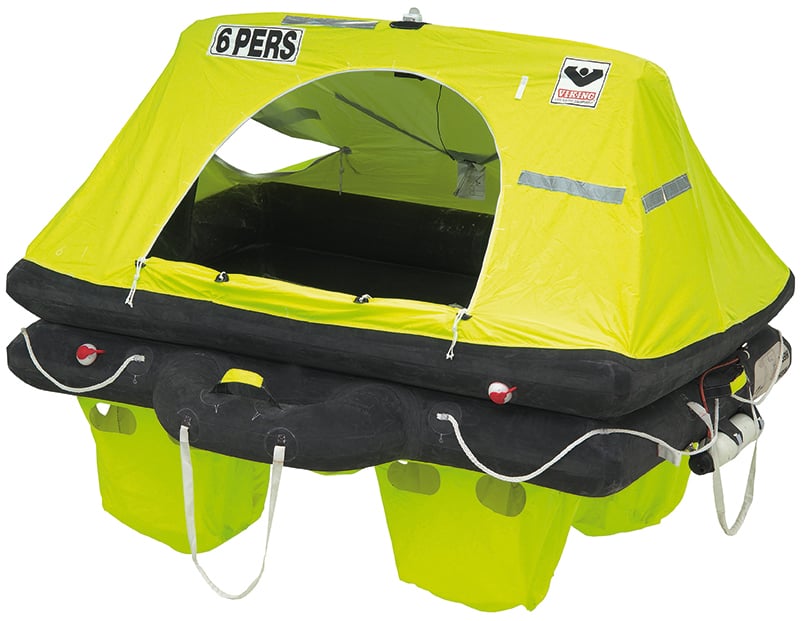
This Viking RescYou™ ISO 9650-1/ISAF Life Raft is a good choice for coastal or offshore cruising or fishing. It is available with a choice of three equipment packs, for greater or less than 24 hour survival gear.
ISO 9650 Type-1 rafts are the most appropriate for boats encountering real offshore conditions including high seas and heavy winds. Two independent, stacked tubes provide redundant flotation should one chamber become damaged. The stacked tube design also provides more freeboard. Many have two entrances, with one entrance including an inflatable boarding ladder to get you aboard from the water. The second entrance is often designed so you can step directly aboard from your disabled vessel.
All have self-erecting canopies. Most will have deep triangular or rectangular ballast bags and a large drogue for stability. Two subgroups fall within this category: Group-A is designed to inflate properly in air temperatures between -15 °C and + 65 °C, and Group-B is designed to inflate properly in air temperatures between 0°C and + 65 °C.
If you’re competing in an ocean race like the Pacific Cup or the Bermuda Race, there will be requirements for approval by World Sailing (formerly ISAF). Check the Offshore Special Regulations for the complete list of requirements, and consider attending one of the Safety-at-Sea Seminars that are held in advance of these races.
Rafts When Rescue Will Take More than 24 Hours
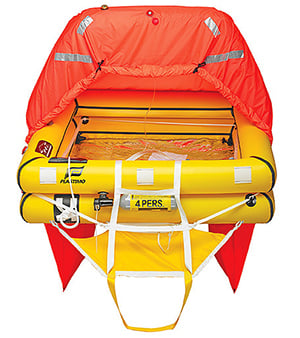
Plastimo’s Transocean ISO 9650 rafts feature two stacking flotation tubes and a self-erecting canopy. Deep ballast pockets (14.5 gallons each) provide stability, drift prevention and stronger anti-capsizing control in rough waters. The foam-coated double floor provides added protection against hypothermia.
The second offshore boating category includes boats traveling beyond the range of quick rescue. ISO 9650 Type-1 life rafts would include an equipment pack designed for more than 24 hours of survival without likely rescue.
SOLAS Transoceanic life rafts: Intended for the toughest conditions, with water temperatures below 41°F, these rafts include the most extensive list of equipment and are the most heavily built to allow self-sufficient survival for extended periods of time. Far from land, rescue agencies and safe harbors, you must have a raft in which you can survive for a week or more. Rafts for offshore use should be more commodious and should have greater stability to survive storms at sea. SOLAS rafts are carried onboard boats in round-the-world races like the Volvo Ocean Race.
Commercial applications: Life rafts for commercial vessels have their own set of requirements concerning carriage of SOLAS A or SOLAS B accessory packs among other unique specifications.
To Buy or Rent a Raft?
You have two options here. If you’re going on a two-year cruising trip where you’ll be voyaging in an open-ended manner, buying a raft is the most cost-effective and convenient. For a single trip, renting from a trusted supplier in your local area is a good option. For example, I chose that alternative for a race to Hawaii in 2016 and rented an offshore Viking RescYou raft from Sal’s Inflatables, a well-respected company in my locale. The price was $450 per month with a non-refundable $150 deposit.
Storage Options
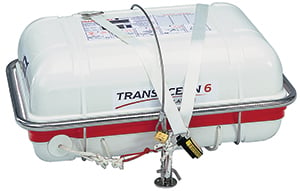
Here is a canister cradle storage system including a hydrostatic release and an anti-theft cable.
Canister: If you are going to store your raft on deck, your raft must be enclosed in a canister. These fiberglass-encased rafts are waterproof and are designed for permanent mounting on a cradle or a lifeline stanchion. They’re manually released by pulling a pin on a shackle. We recommend that you also use a hydrostatic release which will release your raft from its cradle and allow it to float to the surface if you can’t get to it before the boat sinks. We also sell anti-theft cables for security.
Valise: If you store the raft below decks, make sure you can launch it in 15 seconds or less and get a raft packed in a valise. It will be lighter, somewhat cheaper, but much less waterproof than the canister model. For offshore racers, rafts stowed below cannot be heavier than 88lb. (40kg.)
Your Ditch Bag
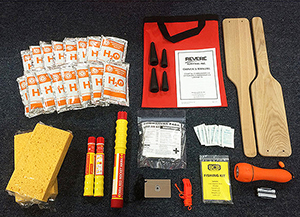
This is all you get in an Offshore Commander 2.0 raft, so you will need a well-stocked ditch bag. The good news is that this four-person valise-encased raft only weighs 67 pounds, so you can lug it on deck.
The gear that comes pre-packaged in a raft is mainly intended for maintaining the raft, not for maintaining you and your crew. That’s why your ditch bag, also called an abandon ship bag, is so important for ensuring your chance at survival. Chuck Hawley, former West Advisor and a global leader in safety for recreational boating, recommends five key items for your ditch bag:
- An EPIRB (preferably) or a PLB. This emergency beacon is the most critical item for getting you rescued.
- An emergency watermaker
- A waterproof handheld VHF radio that uses replaceable alkaline batteries, with spare batteries.
- Any prescription medicines that your crew requires.
- A pair of cheap reading glasses
On my boat, we keep all of our flares, a full complement of SOLAS handheld, aerial and smoke signals, inside a buoyant container stored next to the ditch bag and the life raft.
For an in-depth discussion on what you need in your abandon ship bag, read our West Advisor on Preparing a Ditch Bag.
Launching the Life Raft
You launch the raft by first tying its painter to a strong point on deck, then by throwing the raft in the water and jerking on the painter. It will auto-inflate within less than a minute. Rafts are fragile and easily punctured by any sharp object like a splintered hull, self-steering vane or part of a broken mast. Thus, you should launch the raft on the leeward side of the hull and keep it restrained by a short painter.
Consider waiting to deploy your raft until you’re really planning to board it, because an empty raft alongside your boat is easy to capsize or damage or could break free and be blown away on the wind. There are cases in the annals of high-seas survival where crews have launched their rafts prematurely, just in case something gets worse in a hurry. The raft becomes an attractive option, compared to your boat that’s sinking, on fire or has lost its mast and can tempt you to prematurely abandon ship.
In many of these documented survival stories, crews abandoned their damaged vessels, sometimes facing storm conditions in a raft (as in the 1998 Sydney-Hobart Race) when their boats were later found to be afloat. Remember that your chances of remaining safe and being spotted by rescuers are always better onboard a floating boat than in a life raft.